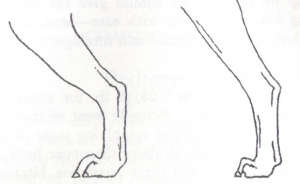
While we should know what our respective breeds were bred to do, dogs are individuals and some may not meet the structural ideal for their breed. For that reason, we should also learn to know what our individual dogs are capable of doing based on the structure they’ve got, not the structure we wish they had.
Take the dog’s stifle, for example. The stifle is a dog’s joint between the upper and lower thighs and could be compared to a human’s knee. It is, for all intents and purposes, a hinge. The leg at the left in the first diagram is what we call a “well bent” stifle, while the leg at the right in the same diagram is “straight.” Which one is more desirable?
Well, it has everything to do with a dog’s breed and purpose. Sledge or cart dogs, especially Arctic breeds, often have straighter stifles to push against the ground to pull weight, an advantage to them. Other dogs need their rear legs to fold under them to do the job they were bred to do. A Dachshund needs her legs under her when she goes to ground after a badger, so she needs well bent stifles. Well bent stifles also give flexibility to the leg which is needed for speed, so a Greyhound needs a well bent stifle to run swiftly. A Chow Chow, on the other hand, doesn’t crawl through badger holes, chase lures or jump over bushes like an Ibizan Hound, so consequently, Chow Chows don’t need well bent stifles, nor does the breed standard call for them.
Look at your dog’s stifles and learn to evaluate whether or not he is built to do what you want him to do. Remember, a dog’s loyalty and huge heart will make her want to please you with little regard for her own discomfort, but it falls upon you to do right by your dog by doing activities she can do with comfort and ability. THIS is why we believe every dog owner should learn about canine structure. It’s not just for dog show fanciers.

